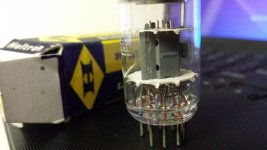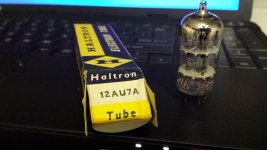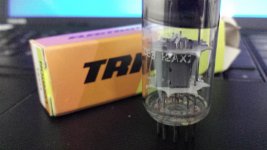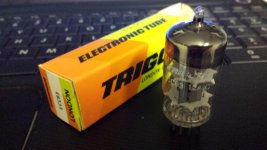I acquired these tubes recently, both appear to be made by RFT in east germany, as they have the welded tags with numbers stamped on them visible.
Anyway, one is marked as Trigon, and the other Haltron.
One is an ECC83/12AX7 and the other is a 12AU7A.
The writing is starting to rub off the tubes, but the markings are still readable.
Both appear to me to look like an ECC81/12AT7.
When I get my tester going, i will be able to confirm the types hopefully.
Check the photos to see for yourself.
Ive seen other trigon tubes listed on online auctions with similar labelling.
Is it possible that the factory has labelled a batch of ECC81 tubes incorrectly?
Anyway, one is marked as Trigon, and the other Haltron.
One is an ECC83/12AX7 and the other is a 12AU7A.
The writing is starting to rub off the tubes, but the markings are still readable.
Both appear to me to look like an ECC81/12AT7.
When I get my tester going, i will be able to confirm the types hopefully.
Check the photos to see for yourself.
Ive seen other trigon tubes listed on online auctions with similar labelling.
Is it possible that the factory has labelled a batch of ECC81 tubes incorrectly?
Attachments
Last edited:
Welded tag with number stamped on it I thought was a sign of Hungarian Tungsram, not RFT. ECC8x can all look similar from the outside, or different, as it is the exact cathode-grid-anode spacing which makes the difference and you usually can't really see this from outside. Incorrect marking is possible.
Sorry you are correct. It is tungstram with the numbered tags. I seem to get those two companies mixed up.
Im pretty sure that they are 12AT7. The small plates are such a giveaway. I have never seen any other double triodes with plates as small as the 12AT7
Im pretty sure that they are 12AT7. The small plates are such a giveaway. I have never seen any other double triodes with plates as small as the 12AT7
Tungsram ECC83 tubes have two supporting rods holding the getter tray, and the mica has more fins than on the second tube.
Well these must be two different tungstram ECC81/12AT7 tubes. You can see that both these tubes have a different amount of points on the mica star patterns.
One also has the numbered tag in the middle of the tube instead of near the top where the getter is.
Interestingly. Ive got another trigon ecc83 tube from tungstram and its got the correct sized plate
One also has the numbered tag in the middle of the tube instead of near the top where the getter is.
Interestingly. Ive got another trigon ecc83 tube from tungstram and its got the correct sized plate
Yes, these plates resemble the plates of those NOS ECC81/12AT7/EC92/6AB4. But I also have seen 12AU7's or 12AX7's of more recent make with the same plates. Put them on your tube tester and check.
Best regards!
Best regards!
Yes, these plates resemble the plates of those NOS ECC81/12AT7/EC92/6AB4. But I also have seen 12AU7's or 12AX7's of more recent make with the same plates. Put them on your tube tester and check.
Best regards!
Yes ill be doing that when i get my tester all working.🙂
The gains (mu) are quite different on ax7, at7 and au7.
If you put them in a circuit you can measure the difference.
If you put them in a circuit you can measure the difference.
How can that be right?
A 12AU7 has more gain than a 12AT7, but less than a 12AX7
The real gain depends of course on the operating point and the circuit of course, but no, 12AT7 has more gain.
ok thats interesting.The real gain depends of course on the operating point and the circuit of course, but no, 12AT7 has more gain.
If i swap them in place of a 12AU7 or 12AX7, the volume is much quieter with the 12AT7.
Interesting that it has much smaller plates also.
These various twin triodes are only swappable in a guitar circuit where a particular type of distortion is needed, as they have quite different bias requirements. As a previous poster showed, 12AU7 has low gain, 12AT7 mid gain and 12AX7 high gain (but only in the right circuit).
These various twin triodes are only swappable in a guitar circuit where a particular type of distortion is needed, as they have quite different bias requirements. As a previous poster showed, 12AU7 has low gain, 12AT7 mid gain and 12AX7 high gain (but only in the right circuit).
Ok interesting to learn.
I thought the numbers meant the level of gain. e.g, the 1 in ECC81 is lower than the 3 in ECC83.
So if say an ECC82 has lower gain, am i correct that it delivers much more current, hence why its popular in phase inverters?
I know 6SN7 is about the same specs as an ECC82, so am interested to know if there are any octal tubes in the same series closer to the ECC81 or 82.
6SN7 has the same gain as ECC82, but is far more linear. Predecessor to ECC82 is ECC32.
6SL7 gain falls somewhere between ECC81 and 83. Predecessors to 6SL7 are 6SC7 or ECC35.
There is no direct octal predecessor to the ECC81 or 83, but there were single triode tubes with mu of 100. 6F5 is one such tube.
6SL7 gain falls somewhere between ECC81 and 83. Predecessors to 6SL7 are 6SC7 or ECC35.
There is no direct octal predecessor to the ECC81 or 83, but there were single triode tubes with mu of 100. 6F5 is one such tube.
OK, thats good to know. I have seen 6SL7 in some designs, and 12SN7 also, but i think the only difference is a 12V heater with the 12SN7.
Are 6SL7 still produced?
Are 6SL7 still produced?
Yes, 6SL7 is still produced, at least by the Chinese anyway.
There are good Russian versions too, 6N9S.
Yes, 12SN7 is just a 12v heater version of the 6SN7. There is the 12SL7 as well.
Bear in mind that the higher the heater voltage, the more likely hum problems will occur, at least with AC heating. Regulated (or better still, constant current) DC heating is the go.
There are good Russian versions too, 6N9S.
Yes, 12SN7 is just a 12v heater version of the 6SN7. There is the 12SL7 as well.
Bear in mind that the higher the heater voltage, the more likely hum problems will occur, at least with AC heating. Regulated (or better still, constant current) DC heating is the go.
The ECC82/12AU7 has low output impedance in a grounded cathode stage or LTP (because of low mu) which may be why some people prefer it as a phase inverter. It makes a poor cathode follower (because of low transconductance); ECC81/12AT7 is better as a CF because of higher transconductance. You need to use the right valve in the right circuit. An ECC82 used as an LTP phase inverter must have a CCS tail because it has low mu and so would be unbalanced with a simple resistor tail.nzoomed said:So if say an ECC82 has lower gain, am i correct that it delivers much more current, hence why its popular in phase inverters?
6SL7 is roughly a predecessor of 5751.
The numbers never mean that. They may, sometimes, indicate order of introduction but you cannot rely on this.I thought the numbers meant the level of gain. e.g, the 1 in ECC81 is lower than the 3 in ECC83.
Tubes are very tolerant and in many (audio) circuits substituting a 12AX7 with a 12AT7 (or the other way) won't result in a dramatic audible change and the test will be inconclusive. Only a check on a tube tester could give you any certainty. I've seen MANY of these (usually Eastern-Europe origin) tubes under various brands with smaller (12AT7-like) plates and they usually measured and performed like they were supposed to (according to the markings on the tube). But "small plate" 12AX7/12AU7's were mostly cheap low grade tubes and a good reason to avoid them. Such cheap production cost-cutting methods are definitely not a good sign...
Last edited:
Tubes are very tolerant and in many (audio) circuits substituting a 12AX7 with a 12AT7 (or the other way) won't result in a dramatic audible change and the test will be inconclusive. Only a check on a tube tester could give you any certainty. I've seen MANY of these (usually Eastern-Europe origin) tubes under various brands with smaller (12AT7-like) plates and they usually measured and performed like they were supposed to (according to the markings on the tube). But "small plate" 12AX7/12AU7's were mostly cheap low grade tubes and a good reason to avoid them. Such cheap production cost-cutting methods are definitely not a good sign...
OK, interesting to know.
Im hoping to get my weston 981 tester going soon.
Still having trouble getting it to work after replacing the leaky caps.
- Status
- Not open for further replies.
- Home
- Amplifiers
- Tubes / Valves
- Incorrectly marked 12AX7/12AT7 tubes from RFT factory?



